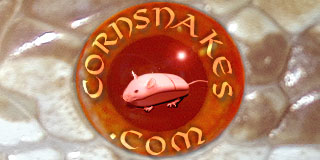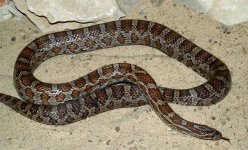abell82
Senile Member
Before you pick this apart because I am not "in" or part of the "click".
PLEASE read what this says, and actually THINK about what it means.
Please forgive me if I go "ALL-OVER" the place. If you need clarification I will be happy to try. PLEASE KEEP IT CIVIL!! :bang:
In another thread, it has been suggested that Miami Phase is NOT an inheritable trait, in a Mendelian fashion.
I suggested that it was and could be discussed in it's own thread, so as not to hijack from the OP.
So here it is. And here are my "Crack pot" ideals and theory on the subject.
( See the Original thread here: )http://www.cornsnakes.com/forums/showthread.php?t=65137
1.) What is a Miami "phase" Corn snake.
TO ME, A Miami "Phase" corn snake is, (in general) a corn snake having a silver / grey ground
color with light orange to dark red saddles. (Not unlike Texas Kistachies.)
These occur NATURALLY, however some of the cleaner animals have been bred in captivity for these traits.
The Miami Phase coloration is NOT a form of albinism, but a "wild type" or Natural coloration.
2.) How does a Miami "phase" Corn snake differ from a "Normal" Corn?
Quite simply they have a silver/grey ground color instead
of an orange or red ground color found in most "Normal" IE:red rat corns.
(For clarification:Wild type Miami Phase corns also prefer anoles to mice etc...)
Now for the fun part.
3.) Is Miami "phase" an inheritable trait?
MY Theory!!
Yes it is inheritable. HOWEVER, It is NOT an on/off, recessive / dominant trait like that of albinism.
It is NOT a form of albinism. It is a natural coloration.
My "theory" is that Miami "phase" is or acts more like an
Incomplete Dominance trait.
Meaning that the miami "phase" coloration, will "mix" with a "normal" snakes coloration and you will get a
blending of the two.
Let's use an analogy here to help. Let's say Miami Corns are akin to Blonde haired Humans, and Red Rats IE: Normal Corns are akin to Brunette haired Humans. Brown hair is dominant to blonde hair. So you get Brown Hair. In subsequent breedings, you will get blonde off spring. BUT, since it is an incomplete dominance, you will get dirty blondes, or strawberry blondes instead of platinum blondes or pure blondes.
So what breeders are doing, by breeding Miami "phase" Corns to "Normal" Corns is in effect breeding blondes to brunettes to try to get Platinum blondes. Will it work? What do you think?
it was suggested By Carol Huddleston, that...
Analogy:Sounds alot like some human babies that are born Blonde haired and blue eyed, only to change later, correct?
IS the Miami "phase" corn snake coloration REALLY a pain in the @$$ or is it the just the way we are looking at it, and what we are trying to do and breeding with it?
IF Miami phase were truly not recessive, How could you breed a Miami to a
Miami and get more Miami's? You wouldn't.
It would be like breeding a polydactyl cat to a polydactyl cat.
All normal toed (or in this case red rat) offspring.
I asked in the other thread, if anyone had ever bred Kisatchie corns to "Normal" Red rats. I did this (and was accused of being all over the place)as I suspect that the Kisatchie corns are also akin to "blondes" so to speak and so when outcrossed the coloration will react, in the exact same or nearly the exact same way that the Miami coloration does.
And that is that the red ground color's of "normal" red rats will dominate the Kistachie's silver grey.
Crack pot idea, or not that far off after all?
PLEASE read what this says, and actually THINK about what it means.
Please forgive me if I go "ALL-OVER" the place. If you need clarification I will be happy to try. PLEASE KEEP IT CIVIL!! :bang:
In another thread, it has been suggested that Miami Phase is NOT an inheritable trait, in a Mendelian fashion.
I suggested that it was and could be discussed in it's own thread, so as not to hijack from the OP.
So here it is. And here are my "Crack pot" ideals and theory on the subject.
( See the Original thread here: )http://www.cornsnakes.com/forums/showthread.php?t=65137
1.) What is a Miami "phase" Corn snake.
TO ME, A Miami "Phase" corn snake is, (in general) a corn snake having a silver / grey ground
color with light orange to dark red saddles. (Not unlike Texas Kistachies.)
These occur NATURALLY, however some of the cleaner animals have been bred in captivity for these traits.
The Miami Phase coloration is NOT a form of albinism, but a "wild type" or Natural coloration.
2.) How does a Miami "phase" Corn snake differ from a "Normal" Corn?
Quite simply they have a silver/grey ground color instead
of an orange or red ground color found in most "Normal" IE:red rat corns.
(For clarification:Wild type Miami Phase corns also prefer anoles to mice etc...)
Now for the fun part.
3.) Is Miami "phase" an inheritable trait?
MY Theory!!
Yes it is inheritable. HOWEVER, It is NOT an on/off, recessive / dominant trait like that of albinism.
It is NOT a form of albinism. It is a natural coloration.
My "theory" is that Miami "phase" is or acts more like an
Incomplete Dominance trait.
Meaning that the miami "phase" coloration, will "mix" with a "normal" snakes coloration and you will get a
blending of the two.
Let's use an analogy here to help. Let's say Miami Corns are akin to Blonde haired Humans, and Red Rats IE: Normal Corns are akin to Brunette haired Humans. Brown hair is dominant to blonde hair. So you get Brown Hair. In subsequent breedings, you will get blonde off spring. BUT, since it is an incomplete dominance, you will get dirty blondes, or strawberry blondes instead of platinum blondes or pure blondes.
So what breeders are doing, by breeding Miami "phase" Corns to "Normal" Corns is in effect breeding blondes to brunettes to try to get Platinum blondes. Will it work? What do you think?
it was suggested By Carol Huddleston, that...
... Miamis are a pain in the a$$. Two perfect Miamis can make very substandard offsring, and even hatchlings that look amazing can turn on you. A lot of my holdbacks end up being sold at 18 months because they start to change. Then after all those years and work, no one wants to pay that much for a "normal". So it really is a labor of love, but to me, they are the most attractive corn out there. It's really a shame it's not a recessive trait.
Analogy:Sounds alot like some human babies that are born Blonde haired and blue eyed, only to change later, correct?
IS the Miami "phase" corn snake coloration REALLY a pain in the @$$ or is it the just the way we are looking at it, and what we are trying to do and breeding with it?
IF Miami phase were truly not recessive, How could you breed a Miami to a
Miami and get more Miami's? You wouldn't.
It would be like breeding a polydactyl cat to a polydactyl cat.
All normal toed (or in this case red rat) offspring.
I asked in the other thread, if anyone had ever bred Kisatchie corns to "Normal" Red rats. I did this (and was accused of being all over the place)as I suspect that the Kisatchie corns are also akin to "blondes" so to speak and so when outcrossed the coloration will react, in the exact same or nearly the exact same way that the Miami coloration does.
And that is that the red ground color's of "normal" red rats will dominate the Kistachie's silver grey.
Crack pot idea, or not that far off after all?

